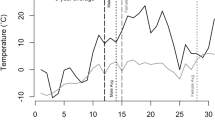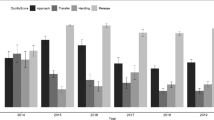Summary
We studied the reproductive success of female Columbian ground squirrels (Spermophilus columbianus) in southwestern Alberta for nine years. We defined reproductive success as the number of offspring surviving their first hibernation, classified as yearlings. The number of weaned juveniles explained one third of the variance in number of yearlings at emergence from their first hibernation the following spring, and much of the variance in individual reproductive success originated after weaning. Weight of adult females at emergence from hibernation was correlated with annual reproductive success. The mother's survival beyond weaning and the subsequent winter's snow accumulation had positive effects on annual reproductive success, whereas population density and summer temperature had negative effects. We found no effects on annual reproductive success of date of litter emergence, weight at emergence as a yearling, presence or absence of adult kin, distance from the natal site, location within the study area, winter temperature or summer precipitation. Age of first breeding did not affect lifetime reproductive success, which ranged from 0 to 19 yearlings produced over a lifetime. The greatest source of variation in lifetime reproductive success for females surviving to breeding age was offspring survival, followed by reproductive lifespan.
Similar content being viewed by others
References
Albon SD, Clutton-Brock TH, Guinness FE (1987) Early development and population dynamics of red deer. II. Density-independent effects and cohort variation. J Anim Ecol 56:69–81
Boag DA, Murie JO (1981) Weight in relation to sex, age, and season in Columbian ground squirrels (Sciuridae: Rodentia). Can J Zool 59:999–1004
Brown D (1988). Components of lifetime reproductive success. In: Clutton-Brock TH (ed) Reproductive Success. University of Chicago Press, Chicago. pp 439–453
Clutton-Brock TH (1988) Reproductive success. In: Clutton-Brock TH (ed) Reproductive Success. University of Chicago Press, Chicago. pp 472–485
Clutton-Brock TH, Guinness FE, Albon SD (1983) The costs of reproduction to red deer hinds. J Anim Ecol 52:367–383
Clutton-Brock TH, Major M, Albon SD, Guinness FE (1987) Early development and population dynamics in red deer. I. Densitydependent effects on juvenile survival. J Anim Ecol 56:53–67
Davis LS (1984) Kin selection and adult female Richardson's ground squirrels: a test. Can J Zool 62:2344–2348
Dobson FS, Kjelgaard JD (1985) The influence of food resources on population dynamics in Columbian ground squirrels. Can J Zool 63:2095–2104
Environment Canada (1979–1988) Monthly record of meteorological observations in Canada.
Festa-Bianchet M (1981) Reproduction in yearling female Columbian ground squirrels (Spermophilus columbianus). Can J Zool 59:1032–1035
Festa-Bianchet M (1989) Individual differences, parasites, and the costs of reproduction for bighorn ewes (Ovis canadensis). J Anim Ecol 58:785–795
Festa-Bianchet M, Boag DA (1982) Territoriality in adult female Columbian ground squirrels. Can J Zool 60:1060–1066
Festa-Bianchet M, King WJ (1984) Behavior and dispersal of yearling Columbian ground squirrels. Can J Zool 62:161–167
Fisher RA (1958) The genetical theory of natural selection. 2nd ed. Dover, New York
Harris MA, Murie JO (1984) Inheritance of nest sites in female Columbian ground squirrels. Behav Ecol Sociobiol 15:97–102
King WJ (1989a) Kin-differential behaviour of adult female Columbian ground squirrels. Anim Behav 38:354–356
King WJ (1989b) Spacing of female kin in Columbian ground squirrels (Spermophilus columbianus). Can J Zool 67:91–95
LeBoeuf BJ, Condit R, Reiter J (1989) Parental investment and the secondary sex ratio in northern elephant seals. Behav Ecol Sociobiol 25:109–117
MacWhirter RB (1989) Antipredator behaviour in the Columbian Ground squirrel, Spermophilus columbianus: vigilance, alarm calling and escape responses. MSc thesis, University of Alberta, Edmonton.
Michener GR, Locklear L (1990) Differential costs of reproductive effort for male and female Richardson's ground squirrels. Ecology 71:855–868
Morton ML, Sherman PW (1978) Effects of a spring snowstorm on behavior, reproduction, and survival of Belding's ground squirrels. Can J Zool 56:2578–2590
Murie JO, Boag DA (1984) The relationship of body weight to overwinter survival in Columbian ground squirrels. J Mammal 65:688–690
Murie JO, Dobson FS (1987) The costs of reproduction in female Columbian ground squirrels. Oecologia 73:1–6
Murie JO, Harris MA (1982) Annual variation of spring emergence and breeding in Columbian ground squirrels (Spermophilus columbianus). J Mammal 63:431–439
Murie JO, Harris MA (1984) The history of individuals in a population of Columbian ground squirrels: source, settlement and site attachment. In: Murie JO, Michener GR (eds) Biology of ground-dwelling squirrels: annual cycles, behavioural ecology, and sociality. University of Nebraska Press, Lincoln. pp 353–373
Murie JO, Harris MA (1988) Social interactions and dominance relationships between female and male Columbian ground squirrels. Can J Zool 66:1414–1420
Sherman PW (1981) Kinship, demography, and Belding's ground squirrel nepotism. Behav Ecol Sociobiol 8:251–259
Smith GW, Johnson DR (1985) Demography of a Townsend ground squirrel population in southwestern Idaho. Ecology 66:171–178
Smith JNM (1988) Determinants of lifetime reproductive success in the song sparrow. In: Clutton-Brock (ed) Reproductive Success. University of Chicago Press, Chicago. pp 154–172
Young PJ (1990) Structure, location and availability of hibernacula of Columbian ground squirrels (Spermophilus columbianus). Am Midl Nat 123:357–364
Author information
Authors and Affiliations
Rights and permissions
About this article
Cite this article
King, W.J., Festa-Bianchet, M. & Hatfield, S.E. Determinants of reproductive success in female Columbian ground squirrels. Oecologia 86, 528–534 (1991). https://doi.org/10.1007/BF00318319
Received:
Accepted:
Issue Date:
DOI: https://doi.org/10.1007/BF00318319




